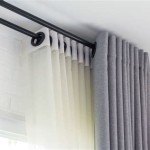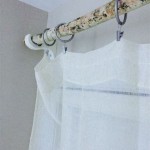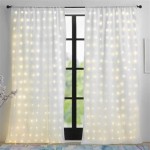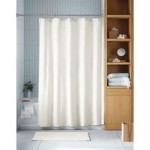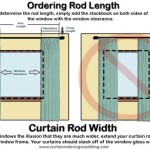Proper Placement of Curtain Rods: A Comprehensive Guide
The strategic placement of curtain rods is a crucial element in interior design that profoundly affects both the aesthetic appeal and functional performance of window treatments. Beyond merely providing a support structure for curtains, the position of the rod significantly impacts perceived room height, light control, and the overall sense of spaciousness. This guide provides a detailed examination of the principles behind proper curtain rod placement, covering various factors to consider for achieving optimal results.
Maximizing the Illusion of Height
One of the most common objectives in interior design is to create the illusion of more significant height in a room. This can be effectively achieved by positioning the curtain rod considerably higher than the window frame. Typically, mounting the rod 4-6 inches above the frame’s top edge is considered a good starting point. However, if the room has low ceilings, the rod can be placed even higher, potentially closer to the ceiling line, to amplify the vertical dimension. This technique draws the eye upwards, making the window and the entire room feel taller and more expansive.
The choice of curtain length is intrinsically linked to this principle. When the rod is placed high, curtains should ideally extend from the rod down to the floor. This unbroken vertical line further enhances the perception of height. Avoid curtains that fall short of the floor, as they can disrupt this visual flow and make the room appear smaller and less polished. If there are baseboard heaters you must consider them to avoid any fire hazard. The distance from the rod to the floor influences the amount of fabric needed and the overall cost of the curtains.
Furthermore, the style of curtain can also contribute to the height illusion. Curtains with vertical stripes or patterns inherently draw the eye upwards, reinforcing the effect of a taller space. Conversely, avoid horizontal patterns in rooms with low ceilings as these can visually compress the space.
When mounting curtain rods high, it is imperative to ensure that the curtains are long enough to reach the floor. Measuring accurately from the rod to the floor before purchasing curtains or altering existing ones is a critical step. Hemming curtains to the precise length will prevent an awkward gap between the bottom of the curtains and the floor. A slight “puddle” of fabric on the floor is acceptable for a more relaxed, romantic look, but this should be a deliberate stylistic choice and not a result of incorrect measurements.
Optimizing Light Control and Window Coverage
The width of the curtain rod and its extension beyond the window frame are critical considerations for optimizing light control and ensuring adequate window coverage. A rod that extends at least 3-6 inches beyond the window frame on each side is generally recommended. This allows the curtains to be fully drawn to the sides, completely exposing the window when desired and allowing maximum natural light to enter the room.
When the curtains are closed, the additional width provided by the extended rod helps to minimize light leakage around the sides of the window. This is particularly important in bedrooms where darkness is essential for restful sleep. Thicker curtains, such as blackout curtains, benefit significantly from wider rod extensions to prevent light seepage.
The type of window being covered also influences the appropriate rod extension. For wider windows, a greater rod extension may be necessary to prevent the curtains from bunching up excessively in the center when fully opened. This ensures a cleaner, more balanced appearance.
Moreover, consider the function of the room. If the room is a home theater or a space where light control is paramount, a wider rod extension is particularly beneficial. This helps to minimize glare and create a darker, more immersive viewing experience. In contrast, in a room where maximizing natural light is a priority, a shorter rod extension might be preferred to allow more light to filter through even when the curtains are partially drawn.
Addressing Architectural Constraints and Practical Considerations
While the principles of maximizing height and optimizing light control are essential, practical considerations and architectural constraints can significantly influence curtain rod placement. Obstacles such as crown molding, window frames, and built-in shelving may necessitate adjustments to the ideal placement.
When encountering crown molding, the rod may need to be mounted below the molding or, alternatively, a special bracket designed to accommodate the molding may be required. Mounting the rod directly onto the molding is generally not advisable as it can damage the molding and compromise the structural integrity of the installation.
Similarly, the presence of unusually large window frames or architectural details may limit the available space for rod placement. In such cases, it may be necessary to consider alternative window treatment options, such as blinds or shades, which can be installed within the window frame.
The type of wall also plays a critical role in determining the appropriate mounting hardware. Drywall requires the use of anchors to provide adequate support for the weight of the curtains and rod. When mounting on plaster or concrete walls, specialized drill bits and anchors are essential to ensure a secure and stable installation. If you are mounting to a stone wall you will need to hire a construction specialist who is familiar with the proper tools to perform the task.
Accessibility for cleaning and maintenance should also be taken into account. Ensure that the rod is positioned in a way that allows for easy removal and reinstallation of the curtains for cleaning. Consider the type of curtain rings or hooks used and ensure they are compatible with the rod and allow for smooth and effortless movement.
Finally, consider the overall aesthetic of the room and the style of the curtains. The placement of the curtain rod should complement the existing décor and enhance the overall visual harmony of the space. A minimalist room may benefit from a simple, understated rod placed close to the window frame, while a more ornate room may warrant a more decorative rod placed higher to create a dramatic focal point. The color of the rod should complement the surrounding trim and window frame.
In addition to these considerations, it is essential to ensure that the rod is level and securely mounted. Using a level during installation will prevent the curtains from hanging unevenly. Regularly inspect the rod and mounting hardware to ensure that they remain secure and free from damage. Addressing any issues promptly will prevent the curtains from falling and potentially causing damage to the wall or window frame.
Ultimately, the proper placement of curtain rods is a multifaceted process that requires careful consideration of various factors. By understanding the principles of maximizing height, optimizing light control, and addressing architectural constraints, one can achieve a window treatment solution that is both aesthetically pleasing and functionally effective. Prioritizing careful planning and precise execution will result in a polished and professional finish that enhances the overall ambiance of the room.
Before commencing any installation, it is highly recommended to consult with a professional interior designer or experienced installer. These experts can provide valuable insights and guidance tailored to specific needs and circumstances, ensuring a successful and long-lasting result. Furthermore, following manufacturer instructions for the curtain rod and mounting hardware is crucial for ensuring proper installation and avoiding potential damage or injury.

How To Install Curtain Rods Best Practices The Shade
How To Hang Curtains In 7 Steps

A Guide To Curtain Measuring And Installation Tms Menagerie

How To Install Curtain Rods 5 Simple Steps

How To Install Curtain Rods Best Practices The Shade

How To Hang A Curtain Rod

How To Style Your Windows Pottery Barn

How To Install Curtain Rods Best Practices The Shade

Drapery Measuring Instruction Twopages Curtains

Hanging Curtains You Re Probably Doing It Wrong Ask The Expert Style Boston Com Real Estate


